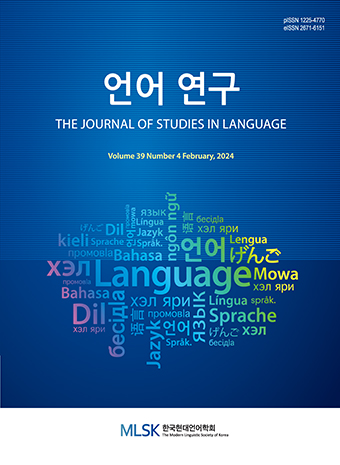Research Article
Abstract
References
Information
The purpose of this study is to explore the underlying forms and formation processes of the syllabic consonants /l/ and /n/, identify issues of previous studies related to them, and then suggest new approaches based on Harmonic theory. For this, we considered the conditions and constraints of syllabic consonants. However, some cases were found which were not consistent with the syllabic conditions or with the restriction of homorganicity between the syllabic liquids and the preceding consonants. As a result, we suggested two different kinds of underlying forms for the syllabic consonants /Cl/ and /əC/ on the bases of word structures, acoustic analyses, and articulation. Also, comparing three approaches that were based on Generative, Government, and Prosodic explanations, we found limitations on each of them. Thus, through adopting Level-approach within the theory, we can explain concisely both the fluctuation of the syllabic consonants and complex phonological phenomena caused by adding the suffixes -ing and -ily to stems.
- 양선기. 2009. 영어음운론. 서울: 한국문화사.
- 전상범. 2004. 음운론. 서울: 서울대학교 출판부.
- Borowsky, T. 1989. Structure Preservation and the Syllable Coda in English. Natural Language and Linguistic Theory 7, 145-166.10.1007/BF00138075
- Cruttenden, A. 1994. Gimson’s Pronunciation of English, 5th ed., London: Arnold.
- Dobson, E. J. 1957. English Pronunciation 1500-1700, 2 Vols., Oxford: Oxford University Press.
- Fallow, D. 1981. Experimental Evidence for English Syllabification and Syllable Structure. Journal of Linguistics 17.2, 309-317.10.1017/S0022226700007027
- Giegerich, H. J. 1992. English Phonology: An Introduction. Cambridge: Cambridge Univeristy Press.10.1017/CBO9781139166126
- Gimson, A. 1989. An Introduction to the Pronunciation of English, 4th edn. London: Edward Arnold.
- Goldsmith. J. 1993. Harmonic Phonology. In J. Goldsmith ed. The Last Phonological Rule. Chicago: University of Chicago Press. 21-60.
- Goldsmith. J. 2000. The Syllable. In J. Goldsmith (ed.) The Handbook of Phonological Theory. Oxford: Blackwell, 160-196.
- Gussmann, E. 1991. Schwa and Syllabic Sonorants in a Non-linear Phonology of English. Anglica Wratislaviensia XVII 1061:25-39.
- Jensen, J. T. 2000. Against Ambisyllabicity. Phonology 17, 187-235.10.1017/S0952675700003912
- Jones, D. 1967. The Phoneme, its Nature and Use. Cambridge:Heffer; 2nd edn, 1962; 3rd edn, 1976.
- Kager, R. 1999. Optimality Theory. Cambridge: Cambridge University Press.10.1017/CBO9780511812408PMC89184
- Kahn, D. 1980. Syllable-structure Specifications in Phonological Rules. Juncture, 91-105.
- Kehoe, M., and Lleó, C. 2003. A Phonological Analysis of Schwa in German First Language Acquisition. The Canadian Journal of Linguistics 48.3-4, 289-327.10.1017/S0008413100000682
- Kenyon, J. S. 1950. American Pronunciation (10th ed.). Ann Arbor, MI: George Wahr.
- Kim, Y. K. 2005. Syllabic Consonants in Early English. Studies in Phonetics, Phonology and Morphology 12.2, 283-305.
- Lakoff, G. 1993. Cognitive Phonology. In J. Goldsmith (ed.) The Last Phonological Rule, 117-145. Chicago: University of Chicago Press.
- Mohanan, K. P. 1985. Syllable Structure and Lexical Strata in English. Phonology 2.1, 139-155..10.1017/S0952675700000403
- Oda, T. 2012. Syllabic Variation and Emergent Phonetic Conditioning. In Phonology of Contemporary English: Variation and Change, University of Toulouse-Le Mirail, 2012 February.
- Oh, K. Y. 1997. Stress Shift and Vowel Laxing in English: Harmonic Approach. Doctoral dissertation. Korea University.
- Oh, K. Y. 2012. Reanalysis of Flapping on Level Approach. English Language and Linguistics 18.3, 225-252.10.17960/ell.2012.18.3.009
- Oh, K. Y. 2014. A Phonological Approach to the Contextual Variances of the English Lateral /l/. English 21 27.3, 363-385.
- Oh, K. Y. 2018. A Comparative Study on the Approaches of ŋ-distribution and its Analyses. Lingua Humanitatis 20.2, 121-152.10.16945/201820205
- Olive, J. P., A. Greenwood and J. S. Coleman. 1993. Acoustics of American English Speech: A Dynamic Approach. New York: Springer-Verlag.
- Roach, P. 2002. A Little Encyclopedia of Phonetics, ms., available at: http://www.personal.rdg.ac.uk/~llsroach/encyc.pdf.
- Rubach, J. 1996. Shortening and Ambisyllabicity in English. Phonology 13.2, 197-237.10.1017/S0952675700002104
- Shockey, L. 2003. Sound Patterns of Spoken English. Oxford: Black Well.10.1002/9780470758397PMC167044
- Szigetvári, P. 2013. Consequence of Sounds: The Consonants and Vowels. Paper presented to the 9th Government Phonology Round Table, Budapest, 20 April 2013. slides.
- Toft, Z. 2002. The Phonetics and Phonology of Some Syllabic Consonants in Southern British English. ZAS Papers in Linguistics 28, 111-144.
- Trager, G. L. 1940. One Phonemic Entity becomes Two: The case of ‘short a’. American Speech 15, 255-58.10.2307/486966
- Trager, G. L., and H. L. Smith. 1951. An Outline of English Structure. Studies in Linguistics, Occasional Papers, no. 3. Norman Oklahoma: University of Oklahoma Press: reprinted in ACLS, Washington DC, 1956.
- Treiman, R., Berch, D., Tincoff, R., and Weatherston, S. 1993. Phonology and Spelling: The Case of Syllabic Consonants. Journal of Experimental Child Psychology 56.3, 267-290.10.1006/jecp.1993.10358301240
- Trubetzkoy, N. S. 1939. Grundzüge der Phonologie (TCLP 7), repr. 1958, Göttingen: Vandenhöck & Ruprecht.
- Wells, J. C. 1995. New Syllabic Consonant in English. In J. Windsor Lewis (ed.) Studies in General and English Phonetics. London: Routledge, 401-412.
- Wolfram, W. and R. Johnson. 2003. Phonological Analysis: Focus on American English. Seoul: HanKukMunhwasa.
- Yavaş, M. 2011. Applied English Phonology (2nd ed.). Wiley-Blackwell.10.1002/9781444392623
- Ziková, M. 2007. Czech Syllabic Consonants revisited. FDSL-7, Leipzig, 30.
- Publisher :The Modern Linguistic Society of Korea
- Publisher(Ko) :한국현대언어학회
- Journal Title :The Journal of Studies in Language
- Journal Title(Ko) :언어연구
- Volume : 35
- No :1
- Pages :23-38
- DOI :https://doi.org/10.18627/jslg.35.1.201902.23




 The Journal of Studies in Language
The Journal of Studies in Language






